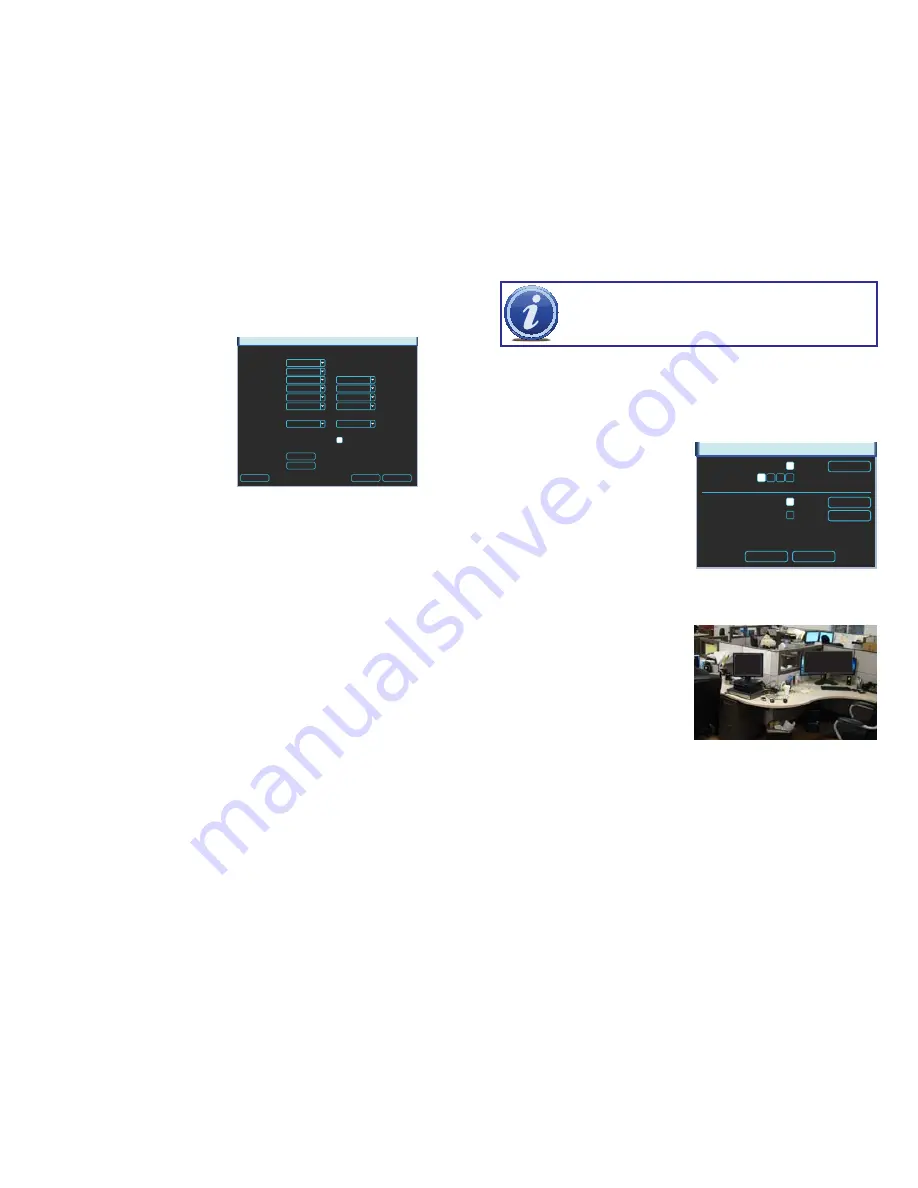
48
49
RECORD SETTING
This window allows you to manage the quality of the recording from each channel as well as
the transmission rate and whether there’s an accompanying audio feed.
As with other windows described earlier, each
channel can be set individually or all at the
same time. Settings can be copied from one
channel and pasted to another. Your settings
will only be saved if you exit the window by
clicking
OK
. Right-clicking or hitting
Cancel
will leave the system with your previous
settings.
There are settings both for the Main Stream
- the video files that record directly onto the
NVR’s hard drive, and the Extra Stream which
is the signal accessed by mobile and remote
devices. These streams run in parallel with
the main stream sent to the hard drive and
they do not affect each other.
RECORD SETTING
Main Stream
Extra Stream
Channel
Type
Compression
Resolution
Frame Rate (FPS)
Bit Rate Type
Bit Rate (Kb/S)
Reference Bit Rate 4096-8192Kb/S
192-1024Kb/S
Audio/Video
1
Regular
1.3M
25
Constant
8192
CIF
H.264
H.264
7
Constant
256
OVERLAY
SNAPSHOT
Copy
OK
Cancel
PICTURE 4-16
NOTE!
Generally, the trade-off for higher quality and increased frame rate is
the amount of room a video file will take on the drive along with how much
“bandwidth” the signal takes up within the system. The larger the files, the
sooner the hard drive will fill up. Setting the drive to overwrite older files will
allow you to maximize the capabilities of your system and cameras.
Audio/Video
– Set by default to enable your system to send both video and audio feeds
(audio requires a microphone located at or near the camera) to your Extra Stream
for use by mobile and remote devices. Disabling a channel can be done to prevent
remote users from accessing a specific camera, but this is better handled in
Account
(see
Section 4.5 Advanced Settings
).
Type
– You are able to change the recording quality based on the type of recording taking
place. For instance, you may have the NVR record at a slower frame rate and/or
resolution during Regular recording to save disk space with the system switching to a
higher resolution and frame rate when the system detects motion or an alarm triggers
an event. Your selections in the pull down are; Regular, MD (Motion Detection) or
Alarm.
Compression
– The default setting is H.264, which is an industry-standard format that greatly
reduces the file size of recordings while maintaining the maximum amount of visual
clarity. It cannot be changed.
Resolution
– This is generally dependent upon the camera connected to the NVR. When the
NVR connects to a camera it’ll determine the maximum resolution. You can always
set this to a lower value. In the Extra Stream, the resolution will be much less - the
320x240 pixel CIF resolution - to allow the video feeds to be uploaded.
Frame Rate (FPS)
– Like Resolution, this is dependent upon the camera. It is variable
between 1 to 30 frames per second. The higher the number, the smoother the
playback.
Bit Rate Type
– Variable versus Constant. Variable provides better compression, but issues
may arise when streaming for remote viewing.
Bit Rate (KB/S)
–Also based on the camera that is connected to your system, this is the
maximum bit rate the selected channel can utilize. You may use the options provided,
or you may customize the bit rate to best suit your network’s capabilities. Your
network may not have enough bandwidth to handle maximum rates from all of your
cameras. Adjusting these settings to suit your network will improve performance and
on-screen image quality.
OVERLAY
Save
Cancel
Set
Cover-Area
Monitor
Set
Time Display
Monitor
Set
Channel Display
Monitor
1
2 3 4
Overlay
– This window allows you to
configure on-screen displays from
the camera as well as providing
the ability to mask off areas from
view. This latter feature is useful
in circumstances such as when a
camera’s field of view includes a
combination lock or other similar
situation. The local user will be able
to view the area but remote viewers
cannot see the area. These privacy
blocks affect both the live view and
playback.
Cover Area
- Clicking the
Monitor
button will
reveal four numbered buttons. These
are the four on-screen areas that you
can set to cover.
Click
Set
to reveal a live view of
the camera’s feed. There will be a
numbered area on the display which
can be moved and re-sized. You
can deactivate any of these areas by
deselecting the numbered button.
PICTURE 4-17
PICTURE 4-18
















































